Welcome to our exploration of the captivating beauty of Salvinia Natans, a delicate floating fern that adds a touch of elegance to water gardens and ornamental ponds.
In this article, we will delve into the unique characteristics and benefits of Salvinia Natans, revealing its leaf arrangement, its role in aquatic ecosystems, and its use in aquascaping.
Join us as we dive into the enchanting world of Salvinia Natans and discover the beauty it brings to your aquatic oasis.
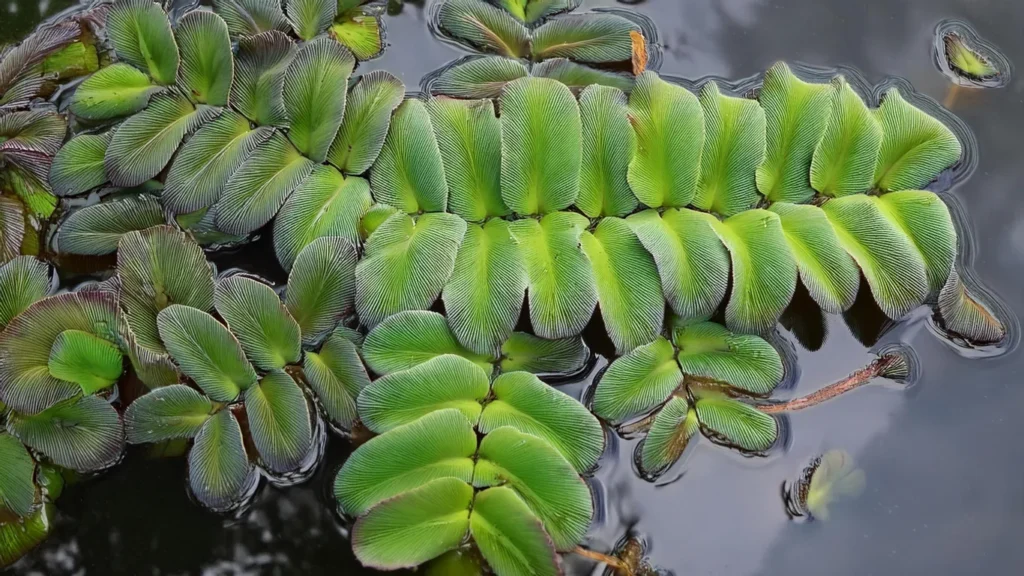
Key Takeaway
- Salvinia Natans is a captivating floating fern that enhances the beauty of water gardens and ornamental ponds.
- Its unique leaf arrangement and graceful appearance make it a sought-after plant among aquatic enthusiasts.
- Salvinia Natans thrives in freshwater environments and contributes to the natural filtration of water, preventing pollution and algae overgrowth.
- When incorporated into aquascaping, Salvinia Natans adds a touch of elegance and creates visually stunning landscapes.
- Propagation of Salvinia Natans is relatively easy, allowing you to expand its coverage in your aquatic landscape.
Quick Stats
| Attribute | Details |
| Family Name | Salviniaceae |
| Origin | Cosmopolitan, found worldwide in temperate regions |
| Height | Floating on the water surface |
| pH Range | 6.0 – 7.5 |
| CO2 Requirement | Low |
| Growth Rate | Fast |
| Care Level | Easy |
| Color Form | Green |
| Water Conditions | 18-28°C (64-82°F), adaptable to a wide range of water hardness |
| Max Size | Can spread indefinitely, but individual plants remain small |
| Lighting | Low to Moderate |
| Supplements | Minimal; benefits from nutrient-rich water |
| Placement | Floating |
| Propagation | Reproduces rapidly through division of daughter plants |
What Is Salvinia Natans?
Salvinia Natans is a variety of floating aquatic ferns known for their graceful appearance and ease of care. This captivating plant effortlessly floats on the water, creating a lush green carpet that enhances the aesthetic appeal of any aquatic environment.
Natural Habitat And Origin
Salvinia natans, commonly known as floating fern or floating moss, originates from various regions around the world, primarily in tropical and subtropical areas.
Its natural habitat includes freshwater bodies such as ponds, lakes, slow-moving rivers, and marshes. Salvinia natans is native to:
- Africa: Salvinia natans is found naturally in various countries across Africa, particularly in sub-Saharan regions. It thrives in freshwater habitats such as marshes, swamps, and slow-moving rivers.
- Asia: This species is widespread throughout Asia, where it inhabits freshwater environments ranging from ponds and lakes to rice paddies. It is native to countries in South Asia, Southeast Asia, and parts of East Asia.
- Europe: In Europe, Salvinia natans is present in certain regions with suitable freshwater conditions, especially in the southern and central parts of the continent. It can be found in marshes, ponds, and streams.
- Americas: Salvinia natans has been introduced to various countries in the Americas. It can be found in freshwater habitats such as ponds, lakes, and rivers. In some areas, it has become invasive, forming dense mats that disrupt native ecosystems.
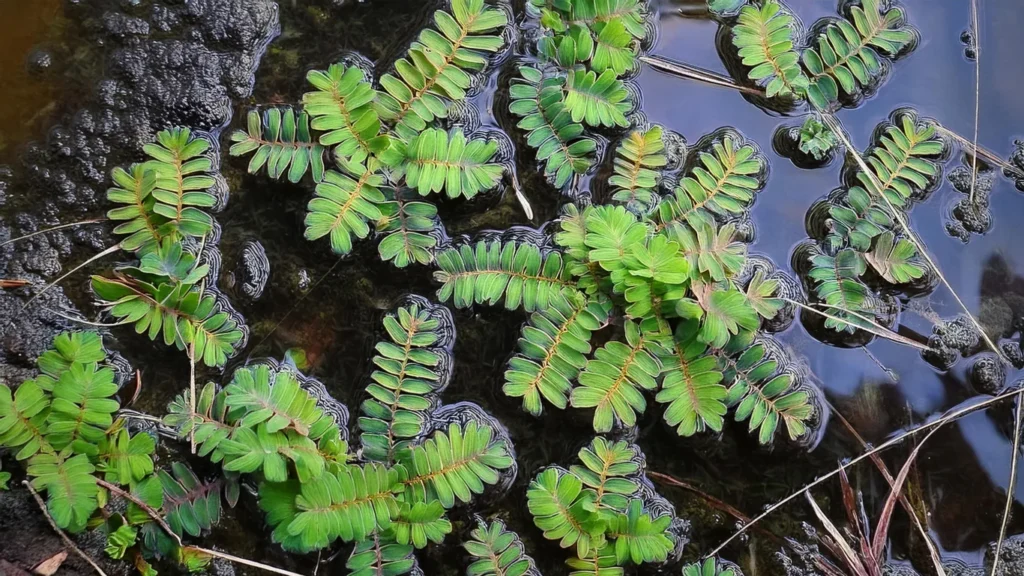
Physical Characteristics
- Floating Leaves: The most prominent feature of Salvinia natans is its floating leaves. These leaves are small, flat, and kidney-shaped, with a distinct notch at the base. Each leaf is covered with fine, water-repellent hairs that give it a velvety texture and help it float on the water’s surface.
- Roots: Salvinia natans has root structures that hang down beneath the water’s surface. These roots are fine and hair-like, serving primarily as anchors rather than for nutrient uptake. The roots absorb some nutrients from the water column but are not as developed as those of submerged aquatic plants.
- Horizontal Stems (Stolons): Salvinia natans reproduces through horizontal stems, also known as stolons, which run along the water’s surface. These stolons produce daughter plants at intervals, allowing the plant to spread rapidly and form dense colonies.
- Size: The size of individual Salvinia natans plants can vary, but they typically range from a few centimeters to several centimeters in diameter. The floating leaves are relatively small, with each leaf typically measuring a few millimeters in length.
- Coloration: Salvinia natans foliage is typically green in color, with variations in hue depending on factors such as light intensity and nutrient availability. Under optimal conditions, the leaves may exhibit vibrant green coloration, while under stress or nutrient deficiencies, the color may appear paler or yellowish.
Lighting Needs
- Moderate to Low Light: Salvinia natans can thrive in moderate to low lighting conditions. It does not require intense lighting like some other aquatic plants, making it suitable for setups with standard aquarium lighting or natural sunlight.
- Indirect Light: Salvinia natans prefers indirect or diffused lighting rather than direct, intense light. Placing the aquarium or pond in areas where it receives gentle, filtered light is ideal. Direct sunlight can sometimes be too intense and may lead to overheating or algae issues.
- Avoiding High Intensity Light: While Salvinia natans can tolerate moderate light levels, it may struggle or show signs of stress if exposed to high-intensity lighting for prolonged periods. Direct sunlight or intense artificial lighting can cause the leaves to wilt, brown, or become damaged.
- Light Duration: Aim for a consistent photoperiod of around 8 to 10 hours of light per day for Salvinia natans. This mimics natural day-night cycles and provides the plant with sufficient light for photosynthesis while allowing for periods of rest.
- Balanced Spectrum: Providing a balanced spectrum of light, similar to natural daylight, is beneficial for Salvinia natans. Full spectrum LED lights or daylight spectrum fluorescent lights are suitable options for aquariums and indoor setups, as they provide the necessary wavelengths for photosynthesis and plant growth.
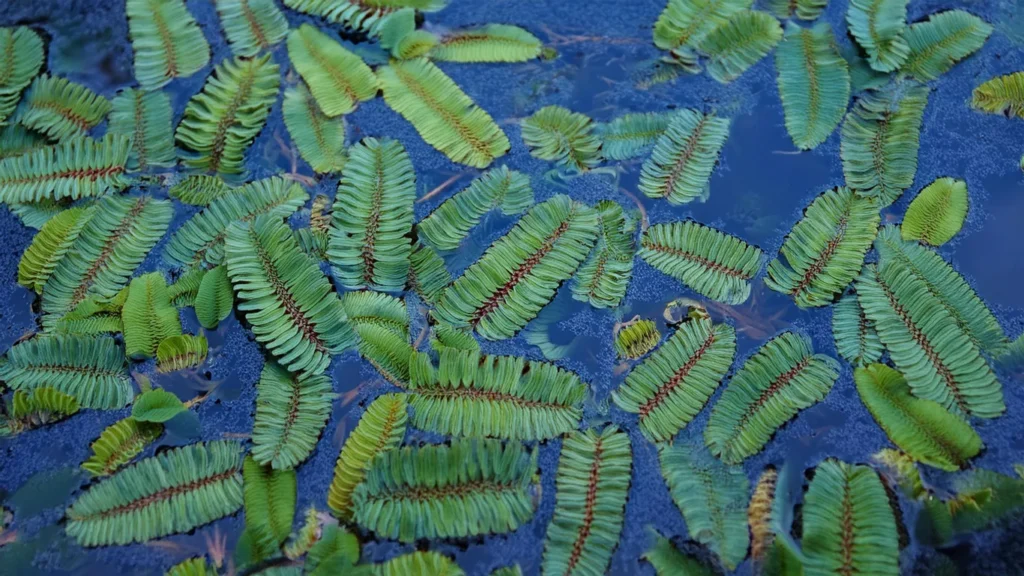
Temperature Parameters For Robust Growth
- Temperature Range: Salvinia natans prefers temperatures typically found in tropical to subtropical regions. The optimal temperature range for robust growth is between 20°C to 30°C (68°F to 86°F). Within this range, the plant’s metabolic processes are most efficient, leading to vigorous growth and healthy development.
- Stable Temperatures: While Salvinia natans can tolerate minor fluctuations in temperature, stability is crucial for robust growth. Avoid sudden or extreme temperature fluctuations, as they can stress the plant and hinder growth. Providing a stable temperature environment within the optimal range helps maintain plant health and vitality.
- Winter Considerations: In colder climates or during winter months, it’s essential to ensure that the water temperature does not drop below the lower end of the optimal range. Sudden drops in temperature can slow down growth or even cause dormancy in Salvinia natans. Using aquarium heaters or other temperature control methods can help maintain stable temperatures during colder periods.
- Summer Heat: In warmer climates or during the summer months, monitor water temperatures to prevent overheating. While Salvinia natans can tolerate higher temperatures within the optimal range, excessively high temperatures can lead to stress and reduced growth. Providing shade or using cooling methods may be necessary to keep temperatures within the preferred range.
Optimal Water Condition
- pH Level: Salvinia natans thrives in slightly acidic to neutral water conditions. Aim for a pH range between 6.5 to 7.5. Fluctuations outside this range can stress the plant and hinder growth.
- Temperature: Maintain water temperatures within the optimal range of 20°C to 30°C (68°F to 86°F) for robust growth. Provide stability in temperature to avoid stress on the plant.
- Water Hardness (GH): Salvinia natans is adaptable to a wide range of water hardness levels (GH). Aim for a general hardness (GH) of 4 to 15 dGH for optimal growth.
- Carbonate Hardness (KH): Ensure a carbonate hardness (KH) of 3 to 8 dKH. Carbonate hardness helps stabilize pH levels and buffer against fluctuations.
- Nutrient Levels: Salvinia natans benefits from moderate nutrient levels in the water. While it can absorb nutrients from the water column, avoid excessive nutrient levels that can lead to algae growth. Regularly test and monitor nutrient levels, including nitrogen (N), phosphorus (P), and potassium (K), to maintain a balanced environment.
- Lighting: Provide moderate to low levels of indirect lighting. Salvinia natans prefers diffused or filtered light rather than direct, intense light. Ensure a consistent photoperiod of around 8 to 10 hours of light per day.
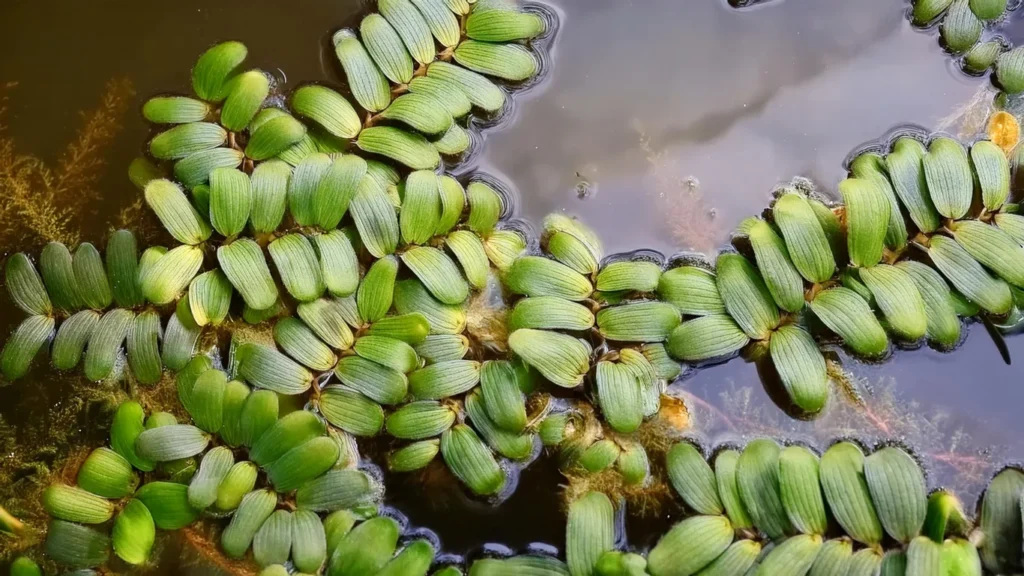
Substrate Requirement
- Salvinia natans, being a floating aquatic plant, does not have substrate requirements like rooted aquatic plants. Instead of rooting in substrate, it floats freely on the water’s surface, supported by its buoyant foliage. Therefore, you do not need to provide any substrate for Salvinia natans in your aquarium or pond.
- However, it’s essential to focus on maintaining water quality and providing suitable water conditions for the health and growth of Salvinia natans. Ensure that the water parameters, such as pH, temperature, hardness, and nutrient levels, are within the optimal range. Additionally, providing appropriate lighting, water movement, and regular maintenance are crucial for the well-being of the floating plants.
- If you have other plants in your aquarium that require substrate, you can still grow Salvinia natans alongside them without any adverse effects. The floating fern will thrive without needing substrate and can provide numerous benefits to the overall aquatic ecosystem, such as oxygenation, nutrient uptake, and shading to reduce algae growth.
Placement Option
- Surface Coverage: Allow Salvinia natans to float freely on the surface of the water, covering a significant portion of the surface area. This placement provides shade and shelter for fish and other aquatic inhabitants while helping to inhibit algae growth by blocking out excess light.
- Aquarium Background: Place Salvinia natans along the back or sides of the aquarium to create a natural background. The floating foliage adds visual interest and depth to the aquascape while also serving practical purposes such as providing hiding places for fish and reducing light penetration.
- Foreground Accent: Use Salvinia natans as a foreground accent by allowing it to drift or cluster near the front of the aquarium. This placement adds texture and dimension to the foreground area, creating a more dynamic and visually appealing layout.
- Pond Borders: Along the edges of ponds or water features, Salvinia natans can be used to create natural borders or accents. Allow the plants to float along the water’s edge, softening the transition between land and water and enhancing the natural beauty of the landscape.
- Natural Filtration Areas: Position Salvinia natans near filtration outlets or areas with water movement to help improve water quality. The floating plants can trap debris and absorb excess nutrients, contributing to natural filtration and maintaining a healthy aquatic environment.
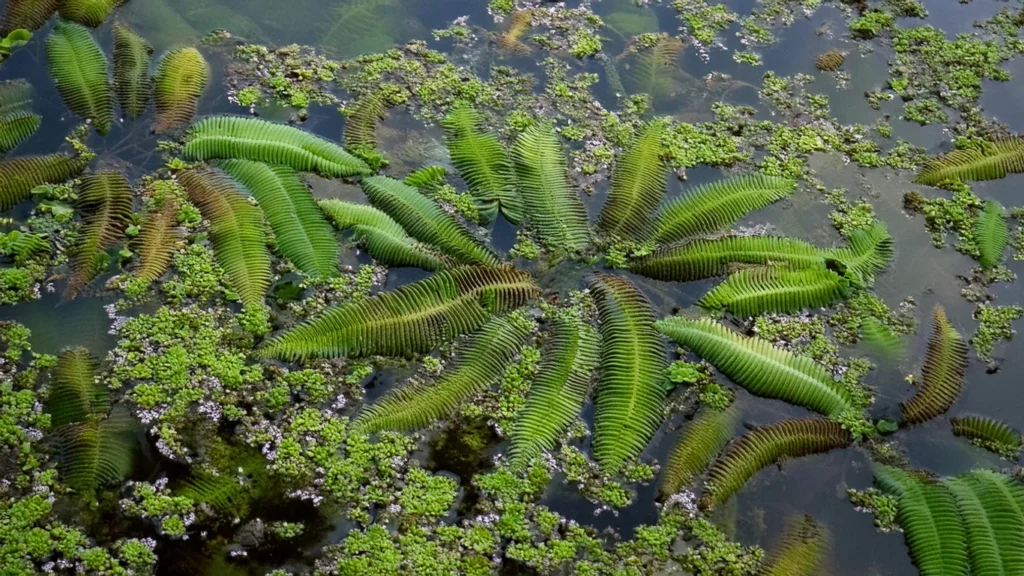
Recommended Tank Size
- Aquarium Dimensions: While Salvinia natans can thrive in tanks of various dimensions, consider the surface area available for the floating plants to spread and grow. Larger surface areas allow for more extensive coverage and provide ample space for the plants to develop without overcrowding.
- Aquascape Design: The recommended tank size may vary based on the aquascape design and layout goals. If Salvinia natans is intended to be a focal point or dominant feature, consider selecting a larger tank size to accommodate its growth and spread. Alternatively, in smaller tanks, Salvinia natans can be used as a complementary element within the overall aquascape.
- Compatibility with Tank Mates: Consider the size and number of tank mates when determining the appropriate tank size for Salvinia natans. Larger tanks provide more space for fish and other aquatic inhabitants to coexist with the floating plants comfortably.
- Maintenance Requirements: Larger tanks typically offer more stability in water parameters and require less frequent maintenance compared to smaller tanks. Consider your ability to maintain water quality and perform regular maintenance tasks when selecting the tank size for Salvinia natans.
Suitable Tank Mates
- Community Fish: Many species of peaceful community fish can coexist harmoniously with Salvinia natans. Examples include tetras, rasboras, danios, guppies, mollies, platies, dwarf gouramis, and smaller species of cichlids like Apistogramma. Avoid aggressive or large fish species that may uproot the plants or disturb the floating mats.
- Shrimp and Snails: Dwarf shrimp species such as cherry shrimp and amano shrimp, as well as small snail species like nerite snails and Malaysian trumpet snails, can make excellent tank mates for Salvinia natans. They help clean the aquarium by consuming algae and detritus while generally leaving the plants undisturbed.
- Bottom-Dwelling Fish: Fish species that primarily inhabit the bottom region of the aquarium can complement Salvinia natans nicely. Corydoras catfish, otocinclus catfish, and small species of loaches like dwarf chain loaches are good options. These fish help with substrate maintenance and add activity to the lower levels of the tank.
- Peaceful Invertebrates: Other peaceful invertebrates, such as freshwater clams and small crayfish species like dwarf crayfish, can coexist with Salvinia natans. Just ensure that any crayfish species are small and not aggressive toward other tank inhabitants.
Nutritional Needs
- Macronutrients: Salvinia natans requires essential macronutrients, including nitrogen (N), phosphorus (P), and potassium (K), for healthy growth. These macronutrients are crucial components of plant tissue and play vital roles in various physiological processes. Nitrogen is particularly important for leaf growth, phosphorus for root development, and potassium for overall plant health and stress resistance.
- Micronutrients: In addition to macronutrients, Salvinia natans requires various micronutrients such as iron (Fe), magnesium (Mg), calcium (Ca), and others. These micronutrients are essential for enzyme function, chlorophyll synthesis, and other metabolic processes within the plant. Iron, in particular, is crucial for preventing chlorosis (yellowing of leaves) and maintaining vibrant green foliage.
- Carbon (CO2): Salvinia natans, like all aquatic plants, requires carbon dioxide (CO2) for photosynthesis, the process by which plants convert light energy into chemical energy. While it can absorb CO2 from the water column, supplementing with additional CO2 can enhance growth and overall health, especially in high-light setups.
- Nutrient Uptake: Salvinia natans primarily absorbs nutrients through its floating foliage and from the water column. It’s essential to maintain balanced nutrient levels in the aquarium or pond to ensure that the plant has access to essential nutrients for healthy growth.
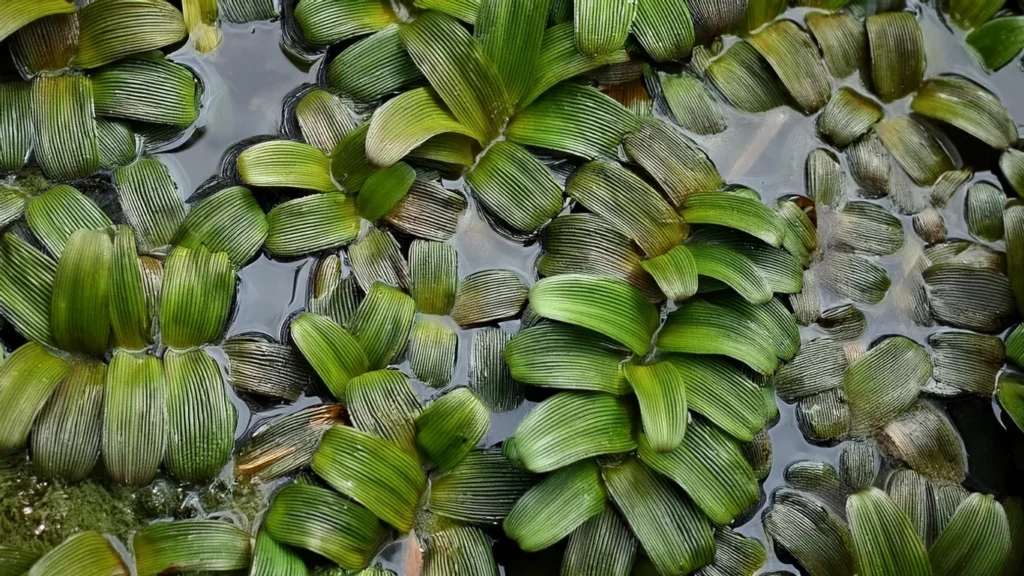
Salvinia Natans Cultivation Tips
- Provide Optimal Water Conditions: Salvinia natans thrives in freshwater environments with stable water parameters. Maintain a temperature range of 20°C to 30°C (68°F to 86°F), a pH level between 6.5 to 7.5, and moderate water hardness (GH) and carbonate hardness (KH). Regular water testing and adjustments will help ensure ideal conditions for growth.
- Provide Moderate to Low Lighting: Salvinia natans prefers moderate to low levels of indirect lighting. Avoid intense, direct light, as it can cause stress or damage to the delicate foliage. Use full spectrum LED lights or daylight spectrum fluorescent lights to provide balanced illumination. Aim for a photoperiod of 8 to 10 hours of light per day.
- Ensure Adequate Water Movement: Salvinia natans prefers gentle water movement. Provide sufficient surface agitation to prevent stagnation and promote gas exchange. Avoid strong currents that may dislodge the floating plants.
- Maintain Nutrient Levels: While Salvinia natans can absorb nutrients from the water column, supplementing with liquid or dry fertilizers can help promote healthy growth. Use a balanced aquarium fertilizer containing essential macronutrients (nitrogen, phosphorus, potassium) and micronutrients. Monitor nutrient levels and adjust fertilization as needed.
Plant Propagation Tips
- Natural Reproduction: Salvinia natans reproduces rapidly through vegetative propagation. It produces daughter plants at the nodes of its horizontal stems, known as stolons. These daughter plants develop into new individuals, forming floating mats or colonies. Allow the plant to propagate naturally by providing suitable conditions for growth and spread.
- Manual Division: You can manually propagate Salvinia natans by separating and replanting daughter plants or clusters of plants. Gently separate the daughter plants from the parent plant by carefully pulling them apart at the nodes. Ensure that each division has a portion of the rhizome (horizontal stem) and roots attached.
- Surface Coverage: Spread the separated daughter plants evenly across the surface of the water to encourage new growth and coverage. Ensure that the plants are not overcrowded, as this can lead to competition for nutrients and hinder growth. Allow sufficient spacing between individual plants to promote healthy spread and prevent matting.
- Regular Maintenance: After replanting the daughter plants, continue to provide optimal care and maintenance to promote healthy growth and propagation. Monitor the plants regularly for signs of stress, nutrient deficiencies, or pest infestations, and take appropriate action as needed.
Benefits Of Planting Salvinia Natans
- Natural Filtration: Salvinia natans helps improve water quality by absorbing excess nutrients from the water column. This can help reduce the levels of nitrogen compounds, phosphates, and other pollutants, leading to clearer and healthier water for fish and other aquatic inhabitants.
- Oxygenation: Like all aquatic plants, It releases oxygen as a byproduct of photosynthesis. By floating on the water’s surface, it promotes gas exchange, increasing the oxygen levels in the water. This benefits fish, invertebrates, and beneficial bacteria, supporting a healthy aquatic ecosystem.
- Shade and Shelter: The floating mats of this plant provide shade and shelter for fish and other aquatic inhabitants. This is especially beneficial for species that prefer dimly lit areas or require hiding places to feel secure. Providing natural cover can reduce stress and aggression among tank mates.
- Algae Control: It can help control algae growth by shading the water’s surface and reducing light penetration. By competing with algae for nutrients and light, it can inhibit the growth of nuisance algae species, helping to maintain a balanced and aesthetically pleasing aquarium or pond.
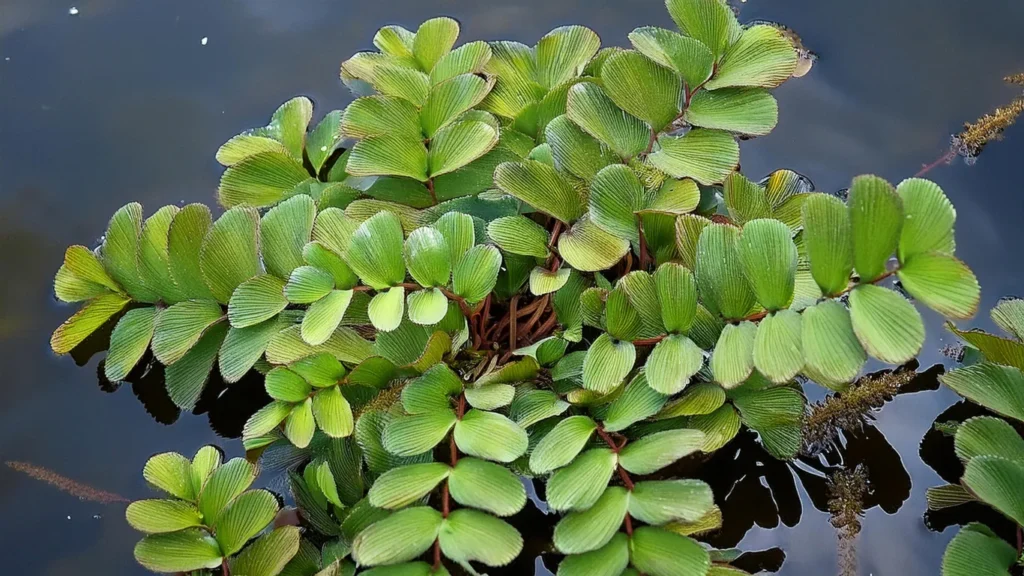
Conclusion
This plant, also known as floating ferns, is an enchanting addition to any water garden or ornamental pond.
Their unique leaf arrangement, natural water purification abilities, and aesthetic appeal make them a sought-after choice among aquatic enthusiasts.
By embracing the beauty of Salvinia Natans, you can create a mesmerizing aquatic haven that offers a serene atmosphere.
Whether you’re an experienced aquarist or a beginner, the ease of care and propagation techniques make it accessible to all.
Explore the captivating charm of Salvinia Natans and elevate the beauty of your aquatic oasis. With their floating elegance, This plant adds a touch of natural beauty to water gardens and ornamental ponds.
Let these floating ferns transform your aquatic space into a haven of beauty and tranquility.
RELATED: Cryptocoryne Wendtii Green Planting Guide For Beginners
Frequently Asked Questions
How Does Salvinia Natans Contribute To Water Purification?
It serves as a natural water purifier by absorbing excess nutrients from the water, such as nitrates and phosphates. This helps prevent water pollution and the overgrowth of harmful algae, promoting a balanced and healthy aquatic ecosystem.
How Can I Incorporate Salvinia Natans In Aquascaping?
This plant can be strategically positioned in an aquarium or water garden to create visually stunning aquatic landscapes. Its lush green carpet can provide focal points, enhance depth, and create a serene backdrop, harmonizing the overall aesthetics of your aquascape.
How Can I Propagate Salvinia Natans?
It reproduces by forming new plantlets at the base of its leaves, making it relatively easy to propagate. Simply separate the new plantlets from the parent plant and gently place them in a suitable location to expand the coverage of the plant in your water garden or aquarium.
What Maintenance Tips Should I Follow For Salvinia Natans?
To maintain healthy pond plants like it, controlling nutrient levels in the water, regularly cleaning the leaves to remove debris or algae growth, and adjusting their placement based on sunlight exposure and water temperature during different seasons are essential.
How Can Salvinia Natans Be Incorporated In Aquatic Design?
In commercial aquatic settings, This plant can add a touch of natural beauty and enhance the overall aesthetics, while in private ponds and ornamental water features, it can elevate the visual appeal and create a tranquil atmosphere.
- Unveiling The Wonders Of Riccia Fluitans In Aquascapes - August 7, 2024
- Vallisneria Gigantea Var. Guide To Care And Cultivation At Home - July 31, 2024
- Vesicularia Dubyana Care & Growth Guide Tips For Beginner Gardeners - July 30, 2024
